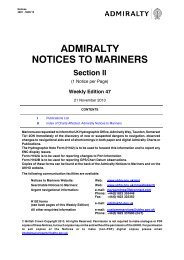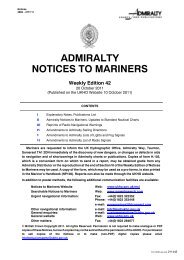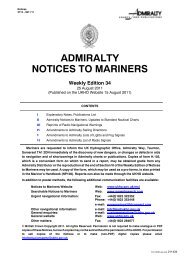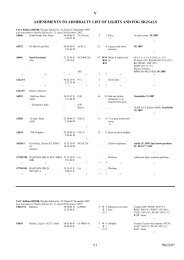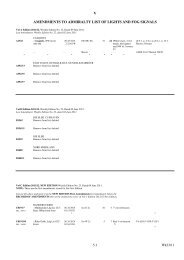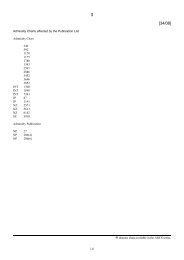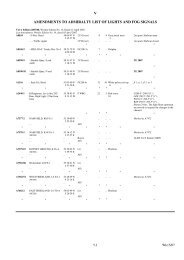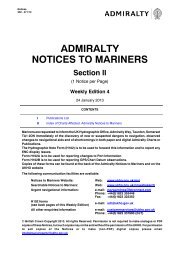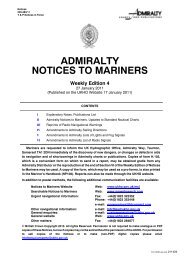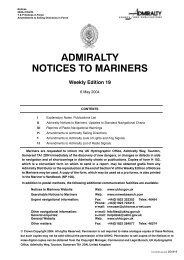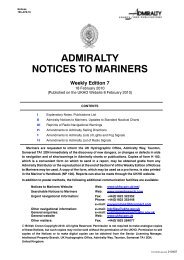Weekly Edition 52 of 2012
Weekly Edition 52 of 2012
Weekly Edition 52 of 2012
Create successful ePaper yourself
Turn your PDF publications into a flip-book with our unique Google optimized e-Paper software.
I<br />
Section VI - Radio Signals<br />
Updates to all the Radio Signals are given in Section VI. When a chart-updating notice is issued for information that is also<br />
included within the Radio Signals, the appropriate volume reference number is quoted, followed in parentheses by the<br />
number <strong>of</strong> the <strong>Weekly</strong> <strong>Edition</strong> containing (in Section VI) the corresponding update to the service details. The updates in<br />
Section VI should be cut out and pasted into the appropriate volumes.<br />
Section VII - Miscellaneous Publications<br />
Updates to the following selected miscellaneous Nautical Publications are contained in Section VII.<br />
NP100 The Mariner’s Handbook<br />
NP133A Paper Chart Maintenance Record<br />
NP231 Admiralty Guide to the Practical Use <strong>of</strong> ENCs<br />
NP294 How to Keep your Admiralty Products Up-to-date<br />
NP136 Ocean Passages for the World<br />
NP350(1) Admiralty Distance Tables – Atlantic Ocean<br />
NP350(3) Admiralty Distance Tables – Pacific Ocean<br />
NP350(2) Admiralty Distance Tables – Indian Ocean<br />
NP735 IALA Maritime Buoyage System<br />
NP5011 Symbols and Abbreviations used on Admiralty Paper Charts<br />
NP5012 Admiralty Guide to ENC Symbols used in ECDIS<br />
All Tides Publications<br />
Nautical Almanac Publications, including Sight Reduction Tables.<br />
Further Guidance<br />
The Mariner’s Handbook (NP100) gives a fuller explanation <strong>of</strong> the limitations <strong>of</strong> charts and details <strong>of</strong> the UKHO policy for<br />
the promulgation and selection <strong>of</strong> navigationally significant information for charts. Details <strong>of</strong> chart updating methods can be<br />
found in “How to Keep Your Admiralty Products Up-to-date” (NP294). All users are advised to study these publications.<br />
CAUTIONARY NOTES<br />
Updating<br />
Updating information is published by <strong>Weekly</strong> Notices to Mariners supplemented by navigational warnings for items <strong>of</strong><br />
immediate importance. It should be borne in mind that they may be based on reports which cannot always be verified before<br />
promulgation, and that it is sometimes necessary to be selective and promulgate only the more important items to avoid<br />
overloading users; the remainder being included in revised editions <strong>of</strong> the charts and publications concerned.<br />
Laws and Regulations<br />
While, in the interests <strong>of</strong> the safety <strong>of</strong> shipping, the UKHO makes every endeavour to include in its publications details <strong>of</strong> the<br />
laws and regulations <strong>of</strong> all countries appertaining to navigation, it must be clearly understood:-<br />
(a) that no liability whatsoever can be accepted for failure to publish details <strong>of</strong> any particular law or regulation, and<br />
(b) that publication <strong>of</strong> the details <strong>of</strong> a law or regulation is solely for the safety and convenience <strong>of</strong> shipping and implies no<br />
recognition <strong>of</strong> the international validity <strong>of</strong> the law or regulation.<br />
Reliance on Charts and Associated Publications<br />
While every effort is made to ensure the accuracy <strong>of</strong> the information on Admiralty charts and within nautical publications, it<br />
should be appreciated that it may not always be complete and up-to-date. The mariner must be the final judge <strong>of</strong> the reliance<br />
he can place on the information given, bearing in mind his particular circumstances, local pilotage guidance and the judicious<br />
use <strong>of</strong> available aids to navigation.<br />
Charts<br />
Charts should be used with prudence: there are areas where the source data are old, incomplete or <strong>of</strong> poor quality. The<br />
mariner should use the largest scale appropriate for his particular purpose; apart from being the most detailed, the larger<br />
scales are usually updated first. When extensive new information (such as a new hydrographic survey) is received, some<br />
months may elapse before it can be fully incorporated in published charts. On small scale charts <strong>of</strong> ocean areas where<br />
hydrographic information is, in many cases, still sparse, charted shoals may be in error as regards position, least depth and<br />
extent. Undiscovered dangers may exist, particularly away from well-established routes.<br />
Satellite-Derived Positions and Chart Accuracy<br />
Mariners must not assume that charts which are referred to WGS84 Datum, or those for which shifts to WGS84 Datum are<br />
provided, have been surveyed to modern standards <strong>of</strong> accuracy. On some charts, owing to the age and quality <strong>of</strong> the source<br />
information, some <strong>of</strong> the charted detail may not be positioned accurately. In such cases mariners are advised to exercise<br />
particular caution when navigating in the vicinity <strong>of</strong> dangers, even when using an electronic positioning system such as GPS.<br />
For further details, see The Mariner’s Handbook (NP100). This applies to both paper and digital (Admiralty Raster Chart<br />
Service and ENC) versions <strong>of</strong> charts.<br />
1.5<br />
Wk<strong>52</strong>/12



